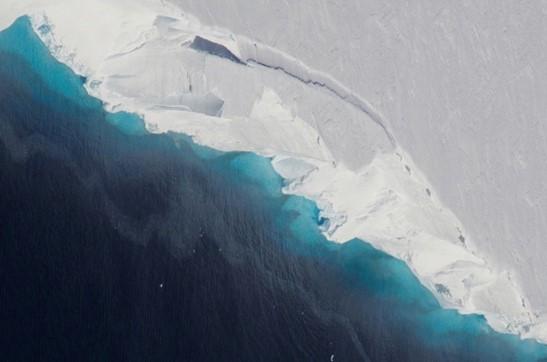Satellites detect daily tidewater incursions under Thwaites Glacier, hastening its melt. Ocean tides are burrowing beneath a thick sheet of Antarctic ice—dubbed the “doomsday glacier” for its threat to global sea levels—and melting it from below. The glacier is more sensitive to ocean water as a result. The incursions could speed up the retreat of the grounding line, currently about 500 meters per year, and accelerate the ice’s march to the sea. The projections we’ve had for retreat have been too conservative.

Ocean tides are burrowing beneath a thick sheet of Antarctic ice—dubbed the “doomsday glacier” for its threat to global sea levels—and melting it from below. The daily intrusions of seawater, detected by satellites, mean the Thwaites Glacier may be disintegrating “much faster” than previously thought, scientists say in a study published today in the Proceedings of the National Academy of Sciences.
“What’s novel about this paper is bringing the ocean tides into the picture,” says New York University oceanographer David Holland, who was not involved in the study. “The tide is really changing the way the glacier melts.”
Melting at Thwaites, an expanse of ice bigger than Florida that stores enough water to raise sea levels by 0.6 meters, already accounts for 4% of global sea level rise. Because the glacier rests on bedrock that dips inland into a deep basin, its underbelly is vulnerable to relatively warm seawater, which melts the ice and, by loosening it from bedrock, hastens its flow into the ocean. And because other West Antarctic glaciers drain into the same basin, scientists believe Thwaites acts as a keystone. Its removal could accelerate the other glaciers’ collapse, potentially unleashing more than 3 meters of global ocean rise in coming centuries. In 2021, researchers noticed fissures on the floating ice at the ocean foot of the glacier, suggesting its crackup may already be underway.
But Thwaites’s remote location, along with thick sea ice in the region, has limited the ability of scientists to examine the glacier up close with sensors, sampling, or undersea vehicles. In the new study, led by glaciologist Eric Rignot of the University of California, Irvine, scientists turned to satellites and a technique called radar interferometry, which can detect millimeter-size changes in surface elevation. The team analyzed radar data collected by the ICEYE satellites, which took snapshots every 3 hours over roughly 4 months in 2023. From the surface displacements, the researchers could glean clues to what was happening 1000 meters below, near the so-called grounding line—the spot where the frozen behemoth detaches from bedrock.
The radar data showed the ice flexing up or down by several centimeters every few hours—movements that indicated massive water pressure from below was “jacking up” the glacier, Rignot says. The grounding line appeared to regularly shift back and forth over a 6-kilometer-long zone, timed with the advance and retreat of the sea tides. The sloshing water means Thwaites has not so much a specific grounding line but a “grounding zone” roughly 200 square kilometers in size, where the daily incursions are gradually widening an invasion route for the ocean. “The glacier is more sensitive to ocean water as a result,” he says.
The data also show that, on occasion, the water travels much farther inland under the ice, far past the grounding zone. During the highest spring tide, a water layer between 5 and 10 centimeters thick flowed as far as 12 kilometers inland. Because that flow happened in concert with the tides, researchers concluded it was seawater, not meltwater from the glacier itself, which is several degrees cooler. That distinction is “really valuable,” says glaciologist Twila Moon of the U.S. National Snow and Ice Data Center, who did not participate in the study.
The incursions could speed up the retreat of the grounding line, currently about 500 meters per year, and accelerate the ice’s march to the sea. Current computer models that forecast Thwaites’s future do not account for seawater intrusions past the grounding line, and a study a decade ago found they could double the speed of the glacier’s melt, Rignot notes. All of which makes the future of the doomsday glacier look even darker. “The projections we’ve had for retreat have been too conservative,” he says.
Sources:
SCIENCE
Provided by the IKCEST Disaster Risk Reduction Knowledge Service System
Comment list ( 0 )
